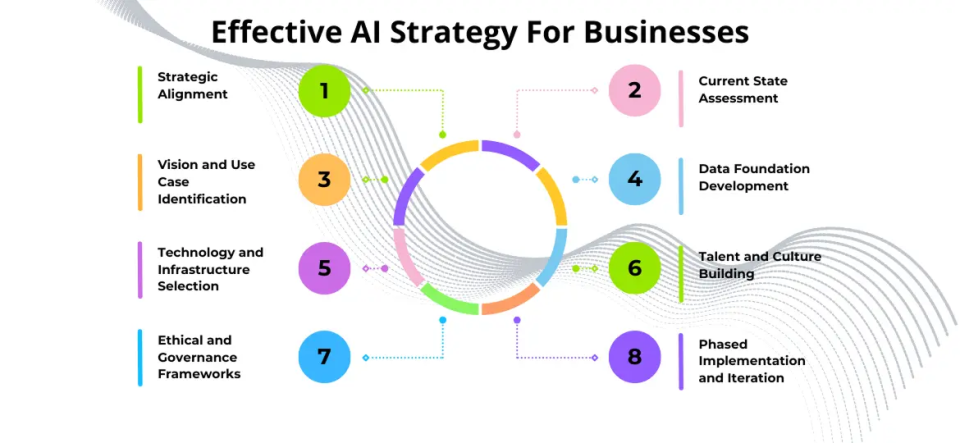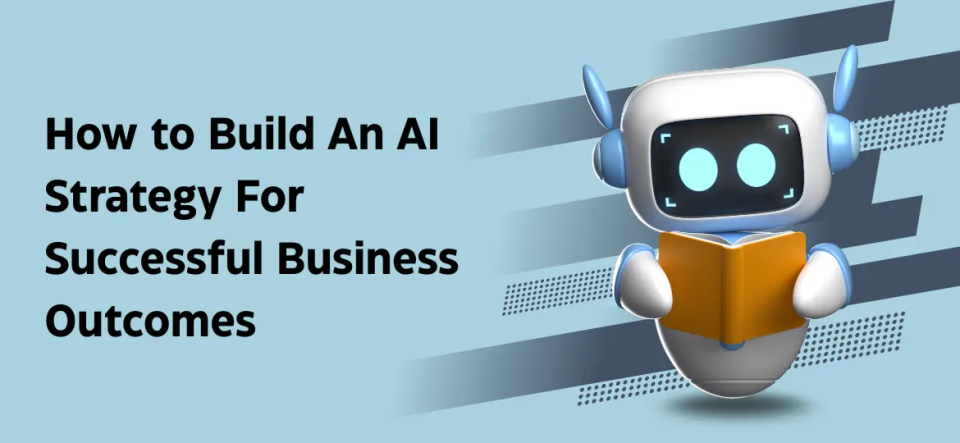Businesses operating in an ever-evolving digital environment face constant pressure to innovate and stay ahead of competition. Artificial Intelligence (AI) has emerged as more than just a buzzword: AI has emerged as an indispensable weapon against competition for companies who embrace its use and transform operations while improving customer experiences. This shift is particularly noticeable within web application and website development where AI may revolutionise our approaches altogether and redefine this aspect of development altogether.
Many businesses rush into AI without first creating an intelligent strategy and plan, leading them to waste resources and achieve subpar results. A well-considered AI plan ensures your AI efforts align with overall business goals while eliminating random implementation and ad-hoc techniques – it creates an easy web development roadmap with clear guidelines on AI integration to maximize benefits from this strategic approach.
This blog post will guide you in developing an AI strategy. Learn to recognize key opportunities through AI technology. We will cover essential foundational elements like data and technology, as well as ethical considerations and scaling your AI initiatives. Discover how AI web development and design can lead to powerful personalization tools; by the time the course ends, you’ll have an in-depth knowledge of all steps necessary for realizing successful business results through AI.
Understanding Your Business and Identifying AI Opportunities
First and foremost, you must gain an in-depth knowledge of your business. Define Business Objectives explicitly to ensure your AI goals align with the business’s objectives. For instance, increasing revenue or decreasing operational costs may be top priorities; customer satisfaction could also be important. Identify specific Key Performance Indicators that AI initiatives can impact to ensure real value is created.
Assess Current State & Gaps. Assess your existing data infrastructure to ascertain its capabilities. Look out for any inefficiencies in existing processes where AI might add significant value, for instance, when manual tasks impede web application development; AI might automate them more efficiently than humans could manage alone. Furthermore, review how robust your AI testing procedures are – will they support future AI integration successfully?
Finally, Brainstorm AI Use Cases. Consider AI from various angles when thinking of ways it might assist. In customer service applications like AI chatbots for instantaneous customer support or personalization engines; predictive maintenance reduces downtime while supply chain optimization becomes possible through AI; marketing/sales AI can assist lead scoring by helping generate content; product design can benefit from optimization that AI offers while suggesting features – just to name some! And in finance applications AI excels at fraud detection and risk evaluation – showing its range of uses! These examples demonstrate AI’s versatility as tools of change.
Roadmap For Effective AI Strategy For Businesses

An effective AI strategy requires a plan. Here’s the road map you need for its successful execution:
Strategic Alignment
Your AI initiatives must directly support core business goals, aligning each project to specific outcomes (for instance if customer retention is of top concern then predictive churn analytics might form part of this). When aligning AI investments with overall success rather than individual projects it provides for an efficient approach and ensures more successful solutions.
Current State Assessment
First, conduct a comprehensive current state evaluation. Take time to understand your existing capabilities – such as what data exists and if systems have reached maturity – as well as any gaps in technology or talent availability that exist in your company. Performing such an evaluation allows you to pinpoint areas where AI could have the most dramatic effects, as well as areas which need improvements prior to its introduction; such as data quality issues that need addressing before AI implementation begins.
Vision and Use Case Identification
Next, create a clear Vision and Use Case Identification plan. Define what AI needs to achieve while brainstorming specific problems it might solve (for instance, can AI accelerate the web application development process by automating testing? Automating user interface improvement or bettering user experiences? Prioritize use cases according to their potential business value. A strong vision guides all subsequent steps taken.
Data Foundation Development
Establish a solid Data Foundation. Development is key for AI success. A strong data infrastructure should support your models; create processes for collecting, storing, and managing it to guarantee quality data that supports all your AI models without fail. Investing early on will only lead to long-term gains.
Technology and Infrastructure Selection
Consider technology and infrastructure selection next. Select appropriate tools and platforms from cloud services or on-premise solutions, and choose AI/ML frameworks explicitly tailored for your use cases. Ensure scalability, as this decision has both performance and financial ramifications.
Talent and Culture Building
Talent and Culture Building is essential. Establish the skillset necessary for an AI strategy, such as data scientists, engineers, and domain experts, in your current workforce before training. Foster a culture that embraces experimentation and learning as you encourage collaboration between technical teams and business units for successful AI implementation. An inclusive culture drives AI adoption forward.
Ethical and Governance Frameworks
Establish ethical and governance frameworks during AI development and deployment processes in order to address any bias present within models, increase transparency in decision making processes regarding user privacy, data protection, compliance regulations etc, build trust while mitigating risks. Establish clear guidelines on AI development and deployment that will foster greater cooperation while mitigating risks.
Phased Implementation and Iteration
Finally, practice Phased Implementation and Iteration. Start small pilot projects. Analyse each phase’s results before iterating AI solutions accordingly based on the results. This approach helps quickly demonstrate value while mitigating risks, while encouraging continuous improvement to achieve optimal AI results.
Conclusion
Building an AI strategy to deliver successful business outcomes can be an ongoing journey, not a one-step solution. Here at CPI, we have explored key steps of this journey; from aligning AI goals with business needs, through to aligning data foundation and talent acquisition decisions, as well as ethics guidelines implementation, then adopting an incremental phased implementation schedule.
Journey requires ongoing efforts. Learning and adapting are key. AI technology advances rapidly while your business requirements will shift over time; your AI strategy must therefore remain adaptable to allow for constant iterations and improvement – take comfort knowing it will ensure long-term success.
Are you looking to explore AI for your business? Echoinnovate IT can assist in navigating this complex landscape. With expert guidance available throughout, our team assists every step of your AI Journey, so contact us now so that we can create an AI Strategy with real results for your organization!
FAQs on How to Build an AI Strategy for Successful Business Outcomes
What is an AI strategy and why is it essential in 2025?
An AI strategy is a structured roadmap that aligns AI capabilities with your business objectives—improving efficiency, decision-making, and value delivery. By 2025, AI is no longer optional; with more than 80% of enterprises deploying generative AI, a clear AI strategy is now a strategic imperative for achieving ROI.
What are the key components of a successful AI strategy?
Effective AI strategies include clear business goals, governance, pilot projects, use-case prioritization, metrics/KPIs, and ethical frameworks. Frameworks from sources like Microsoft, RSM US, and Corsica Technologies highlight these core pillars.
How do I align AI initiatives with my business vision?
Begin by defining measurable objectives (e.g., cost savings, customer engagement). Align AI investments with these goals to avoid fragmented or pilot-only efforts. A top-down approach anchored in strategic outcomes ensures scalable impact.
What process should I follow to identify and prioritize AI use cases?
Start by identifying high-impact use cases through a strategic prioritization matrix that considers business value, feasibility, and scalability. Validate via pilot tests, then scale successful initiatives enterprise-wide.
How can I measure and track the success of my AI strategy?
Measure AI performance through well-defined KPIs tied to business outcomes—ROI, efficiency gains, customer metrics. Use a lifecycle approach: pilot → production → scale, tracking and iterating at each stage.



